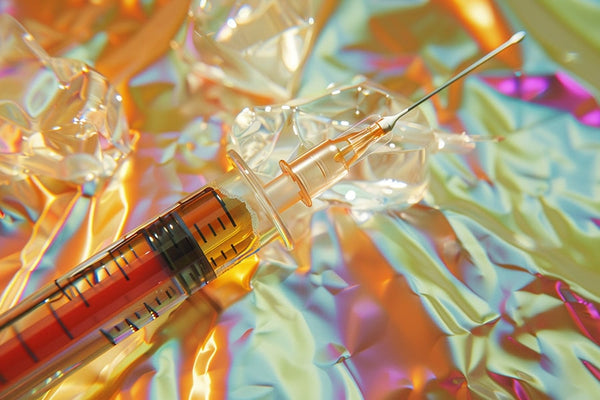For many transgender men and nonbinary individuals assigned female at birth (AFAB), transitioning is a deeply personal and transformative journey. One of the most impactful and empowering steps in that journey is often hormone replacement therapy (HRT). Taking testosterone as part of HRT can help align the physical body with a person’s gender identity, offering relief from dysphoria, a sense of affirmation, and newfound confidence.
But what exactly does HRT involve? What changes can you expect, and how do you get started? This guide dives deep into the role of testosterone in FTM (female-to-male) transition, answering your burning questions, dispelling myths, and helping you feel informed and empowered about this crucial step in your journey.
What Is Hormone Replacement Therapy?
Hormone replacement therapy (HRT) involves taking hormones to bring physical characteristics into alignment with one’s gender identity. For transgender men and some nonbinary people, HRT typically involves testosterone therapy, which induces masculinizing changes in the body.
HRT is not just about physical changes—it’s also about emotional well-being, gender affirmation, and living authentically. It can provide immense relief from gender dysphoria while offering a sense of empowerment and alignment with your true self.
How Does Testosterone Work?
Testosterone is the hormone responsible for triggering masculinizing changes in the body. When taken as part of HRT, it mimics the natural levels of testosterone typically found in cisgender men, promoting changes like a deeper voice, facial hair growth, and increased muscle mass.
Testosterone is typically administered in one of the following forms:
- Injections: The most common method, involving regular doses of testosterone via intramuscular or subcutaneous injections.
- Topical Gel or Cream: Applied daily to the skin and absorbed into the bloodstream.
- Patches: Adhesive patches that release testosterone through the skin.
- Pellets: Implanted under the skin and release testosterone over several months (less common).
Your healthcare provider will work with you to choose the best option based on your lifestyle, medical history, and preferences.
Physical Changes on Testosterone
One of the most exciting aspects of HRT for many trans men is the physical transformation. While everyone’s timeline and results vary, here are some common changes you can expect:
1. Voice Deepening
- One of the earliest and most noticeable changes.
- Your voice may start to crack or feel rough as your vocal cords thicken, similar to a second puberty.
2. Facial and Body Hair Growth
- Over time, you’ll notice increased hair growth on your face, chest, stomach, arms, and legs.
- Full beard growth may take several years, depending on genetics.
3. Fat Redistribution
- Body fat will shift away from typically “feminine” areas like the hips and thighs and move toward the abdomen and torso.
- This creates a more masculine body shape.
4. Increased Muscle Mass and Strength
- Testosterone promotes muscle development, making it easier to build strength with exercise.
- You may also notice a more defined jawline or shoulders.
5. Menstrual Cessation
- Periods typically stop within a few months of starting testosterone. This can provide significant relief for those with dysphoria related to menstruation.
6. Skin and Hair Texture
- Your skin may become oilier, and acne is common during the first year of HRT.
- Hair texture may change, and you might notice a receding hairline or thinning hair over time.
7. Genital Changes
- The clitoris typically enlarges (a process called clitoral growth or “bottom growth”).
- Sensitivity in the genital area may also increase.
Pro Tip: Many changes happen gradually over time, so patience is key. Testosterone’s effects can take years to fully develop, much like the natural puberty process.
Emotional and Mental Changes
While HRT is often celebrated for its physical changes, it also brings emotional and psychological shifts:
- Relief from Dysphoria: For many trans men, testosterone alleviates the distress caused by gender dysphoria.
- Increased Confidence: Seeing your body change in ways that align with your gender identity can boost self-esteem.
- Mood Shifts: Some people report changes in mood or emotional regulation. If you experience intense emotions, it’s important to discuss this with your healthcare provider.
Remember, every person reacts differently to testosterone. Emotional changes can vary based on your personality, mental health, and support system.
Starting HRT: What to Expect
Starting testosterone therapy involves several steps, and the process may vary depending on your location and healthcare system. Here’s a general outline of what to expect:
1. Initial Assessment
- You’ll meet with a healthcare provider or gender-affirming specialist to discuss your goals, medical history, and mental health.
- Blood tests may be required to check your baseline hormone levels and overall health.
2. Informed Consent
- Many clinics use an informed consent model, meaning you’ll learn about the effects, risks, and benefits of HRT before deciding to start.
3. Prescription and Administration
- Once cleared, you’ll receive a prescription for testosterone in your chosen form (injection, gel, etc.).
- Your provider will show you how to administer it safely, especially if you’re using injections.
4. Follow-Up Appointments
- Regular check-ins with your provider are essential to monitor your hormone levels, adjust your dosage, and address any side effects.
Potential Risks and Side Effects
While HRT is generally safe when prescribed and monitored by a healthcare provider, there are some potential risks and side effects to be aware of:
Common Side Effects:
- Acne (especially during the first year).
- Increased appetite.
- Changes in mood or energy levels.
Long-Term Risks:
- Increased Red Blood Cell Count: Can thicken the blood, increasing the risk of blood clots.
- Cholesterol Changes: Testosterone can raise LDL (“bad”) cholesterol and lower HDL (“good”) cholesterol.
- Possible Impact on Fertility: Testosterone often suppresses ovulation, and long-term use may make it harder to conceive in the future.
Pro Tip: Discuss fertility preservation (like egg freezing) with your provider if having biological children is important to you.
The Emotional Impact of HRT
For many trans men, starting HRT is a life-changing moment. The changes it brings can feel euphoric, empowering, and validating. However, it’s also normal to experience a mix of emotions as your body transforms.
What to Keep in Mind:
- It’s a Journey: HRT is not an overnight process—it’s a gradual transformation that unfolds over time. Celebrate the small milestones along the way.
- Every Body Is Unique: Your results may not look exactly like someone else’s, and that’s okay. Your journey is your own.
- Build a Support System: Having people to share your experiences with—whether friends, family, or the trans community—can make the process feel less isolating.
Is HRT Right for You?
Deciding to start testosterone therapy is deeply personal. It’s not a requirement for being trans, and your identity is valid whether or not you choose HRT. Take the time to reflect on what feels right for you, and don’t hesitate to reach out to supportive professionals or community members for guidance.
Final Thoughts
Hormone replacement therapy is about so much more than physical changes—it’s about stepping into your truth, finding relief from dysphoria, and becoming the person you’ve always known yourself to be. Testosterone can be a powerful tool in your journey, but remember: it’s only one part of the larger story of your transition.
Whether you’re just beginning to explore HRT or you’ve already started, know this: your journey is valid, your identity is real, and you deserve to feel at home in your body.
The Impact of HRT on Physical and Emotional Well-being
Hormone Replacement Therapy (HRT), also known as gender-affirming hormone therapy, is a cornerstone of the transition process for transgender men and transmasculine individuals.
This transformative journey involves the administration of androgens, primarily testosterone, to foster physical changes that reflect an individual’s true gender identity.

Understanding Masculinizing Hormone Therapy
Masculinizing hormone therapy is designed to induce masculine secondary sex characteristics. Through testosterone administration, individuals experience significant changes including increased muscle mass, the emergence of facial and body hair, and the deepening of the voice.
The therapy can be administered in various forms such as injections (intramuscular or subcutaneous), oral medications, transdermal patches, gels, or subcutaneous implants, with injections being among the most common and effective methods.

Expected Changes and Monitoring for Safety
The journey with HRT brings both reversible and irreversible changes. Reversible effects encompass increased libido, redistribution of body fat, cessation of menstruation, heightened muscle mass, and potential acne.
Irreversible changes, marking a profound step in the transition, include the deepening of the voice, growth of facial and body hair, male-pattern baldness, and changes in genitalia.
While HRT is generally safe under medical supervision, potential risks such as polycythemia, weight gain, acne, hair loss, hypertension, and lipid profile changes necessitate regular monitoring.
This ensures that the therapy is both effective and minimally hazardous, allowing for adjustments as needed.

Navigating Access and Eligibility
The accessibility of masculinizing hormone therapy varies greatly by location and healthcare systems.
The adoption of an informed consent model by many healthcare providers has significantly eased the path to starting HRT, focusing on patient autonomy and understanding.
This approach eliminates the need for extensive psychiatric evaluations traditionally required, facilitating a more straightforward and respectful journey toward beginning hormone therapy.

The Profound Impact of HRT in FTM Transition
Masculinizing hormone therapy is not just a medical procedure; it’s a vital step towards aligning one’s physical presence with their gender identity. The psychological and emotional benefits of seeing and feeling one’s body reflect their true self are immeasurable.
However, it’s crucial for individuals to engage closely with healthcare providers, ensuring a safe and tailored approach to hormone therapy.

In conclusion, masculinizing hormone therapy plays an indispensable role in the FTM transition, marking a pivotal step in the journey of transgender men towards living authentically.
By understanding the nuances of this therapy, including its benefits, potential side effects, and the processes of accessing care, individuals can navigate their transition with confidence and support.



Leave a comment